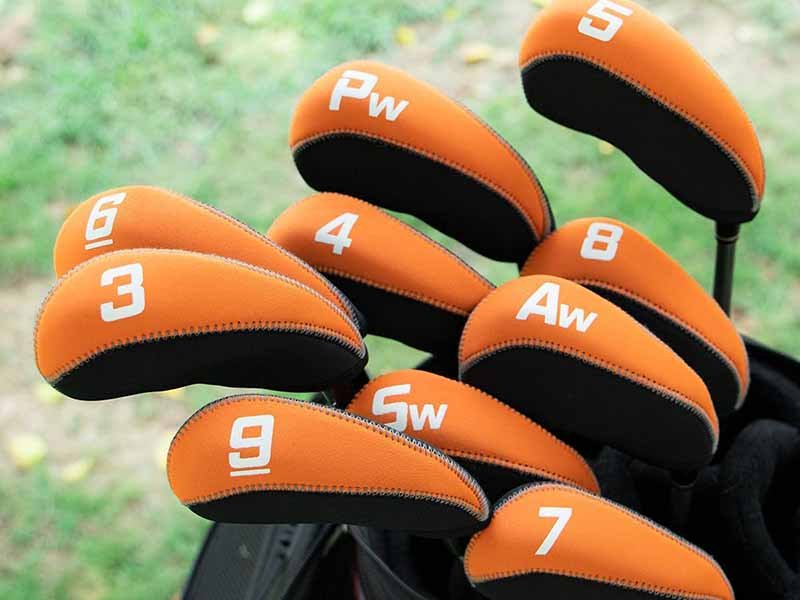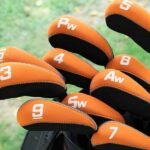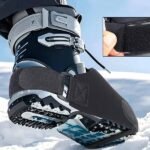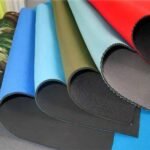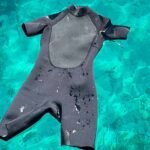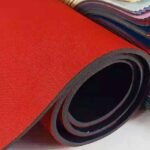Golfers love their clubs—some might say a bit too much. Whether it’s a brand-new forged iron set you saved up for, or a custom-shafted build that feels like an extension of your hands, protecting your gear becomes more than just a practical decision; it’s emotional. Yet the strange thing is this: most golfers spend thousands on irons but hesitate to spend a fraction of that on iron covers that could keep them looking pristine for years.
If you’ve ever pulled your club from the bag and spotted a fresh ding, a new scratch, or that annoying “bag chatter” mark created during a bumpy cart ride, you already understand why iron covers matter. And this is exactly why more golfers are now searching online for the best golf iron covers—not just to keep their clubs clean, but to keep them valuable.
The best golf iron covers offer strong padding, a secure fit, water-resistant materials, and easy on/off access to protect irons from scratches and bag chatter. Neoprene covers are most popular for everyday play due to flexibility and durability, while magnetic or leather-style covers offer premium aesthetics. Choosing the right set depends on club size, usage frequency, travel needs, and golfer preference.
Back to the story—years ago, a golfer told me he bought a used set of Mizuno irons that looked completely untouched. Why? The previous owner used iron covers religiously. The irons performed like new, but more importantly, the resale value remained nearly identical to a fresh set. That moment convinced him—and many others—that iron covers are not just accessories; they’re quiet financial decisions disguised in soft fabric.
And if you’re reading this, chances are you’re looking for better protection, smarter buying advice, or even custom-branded neoprene covers for your shop, event, or golf brand.
Let’s dive deep.
What Are Golf Iron Covers and Why Do They Matter?

Golf iron covers are protective sleeves designed to prevent irons from getting scratched, dented, or chipped during transport and play. They reduce “bag chatter,” shield premium forged heads, and maintain the cosmetic and resale value of golf clubs. Most covers are made of neoprene, leather, PU, or knit materials and fit over the entire clubhead. They matter because they extend equipment lifespan—especially for golfers who travel, play often, or own high-end clubs.
Many golfers underestimate the importance of iron covers until the first scratch appears on a brand-new club. Golf bags, golf carts, travel cases—even walking—introduce constant motion. As irons collide with each other, minor dings accumulate. This is normal, but “normal” becomes a problem when you realize how quickly cosmetic wear affects not only appearance but also value.
Think about forged irons, for example. They’re softer by nature. Stainless steel is tough, but forged carbon steel dents easily. A single season without protection can make a $1,200 set look like it survived a decade of abuse. That alone is enough reason why many golfers quietly slip covers on after each shot—especially those who’ve upgraded to high-end irons like Mizuno, Miura, PXG, Titleist, or Honma.
1. Protection Beyond Scratch Prevention
Golf iron covers do more than prevent bag chatter.
They also reduce:
- Rain and moisture exposure(helps prevent rust on carbon-steel clubs)
- Damage from airline transport
- Loss of shine caused by abrasive contact during walking rounds
- Unwanted clanking noises during play or travel
The last point might sound minor, but many golfers, especially early-morning walkers, prefer quieter rounds. Covers dramatically reduce noise.
2. Value Preservation (The Most Overlooked Benefit)
Golf clubs aren’t cheap. Better yet: they retain surprising resale value—if they look clean. Selling a used iron set with visible chatter marks can reduce resale price by 20–40%. Covers eliminate that problem discreetly and economically.
3. A Matter of Personality and Preference
Some golfers enjoy the “wear and tear” look—it feels like a badge of honor. Others see clubs as tools that should remain clean and sharp. Iron covers bridge both worlds by giving golfers control: use them during cart rides, travel, or long storage; remove them during rapid play if preferred.
4. Ideal for Golfers Who Travel or Play Often
If you frequently fly with your clubs, you’ll understand this instantly: travel bags shift violently. Irons slam against each other with every bump, conveyor drop, or vehicle transfer. Iron covers offer a personal insurance policy.
Are Golf Iron Covers Really Necessary or Just a Style Choice?

Golf iron covers are more than a style accessory—they provide real protection against scratches, bag chatter, moisture, and travel damage. While some golfers consider them unnecessary, they are essential for anyone using forged irons, traveling frequently, or wanting to maintain resale value. Covers help preserve both appearance and long-term performance, making them practical for many golfers rather than just a cosmetic choice.
If there’s one topic that divides golfers more than ball markers or glove rules, it’s iron covers. Some players swear by them; others roll their eyes whenever they hear the word. The truth? Both sides have a point. And understanding this debate helps you decide where you stand—and what your clubs actually need.
1. The Practical Side: Why Many Golfers Consider Iron Covers Essential
Let’s start with function.
Iron covers physically prevent:
- Bag chatter during cart rides
- Cosmetic scratching from steel-on-steel contact
- Dings that affect forged irons
- Rust caused by moisture sitting on carbon steel
- Travel damage when flying with clubs
- Clubs clanking loudly during walking rounds
Golf equipment isn’t cheap. A modern iron set ranges from $600 to over $2,000, and brands like Miura, PXG, or Honma go even higher. When you carry that kind of investment around, protection stops feeling optional.
And the truth is simple:
iron covers cost less than 1% of your clubs, yet they can preserve 20–40% of resale value.
That’s not emotional—it’s financial math.
2. The “Unnecessary” Argument: Why Some Golfers Dislike Them
On the other side, you have golfers who argue:
- “Covers slow down play.”
- “Professionals don’t use them.”
- “Good clubs should show natural wear.”
- “They look bulky or old-fashioned.”
In fairness, some of these concerns are valid. If a golfer constantly removes and replaces covers between every shot, pace-of-play can suffer. And yes, many PGA professionals skip covers because their gear is replaced often, or they’re working with hard-wearing tour heads.
But everyday golfers aren’t replacing irons every few months like the pros.
3. The Hidden Middle Ground: More Golfers Use Covers Than You Think
Here’s a truth you rarely hear:
Most golfers who own expensive forged irons use covers—just quietly.
They slip them on after a round, during travel, or when tossing clubs in the car trunk.
The “no covers ever” stance is more loud than common.
4. Depending on Your Clubs, They’re Either Optional… or Essential
Are you using:
- Cast stainless irons? → Covers are optional but helpful.
- Forged blades or players’ irons? → Covers are strongly recommended.
- Luxury brands (Miura, Epon, Honma)? → Covers are essential.
- Play frequently or travel often? → Covers become a must-have.
In short:
Iron covers aren’t for everyone—but for the golfers who need them, nothing else can replace them.
What Factors Make a Golf Iron Cover “the Best”?
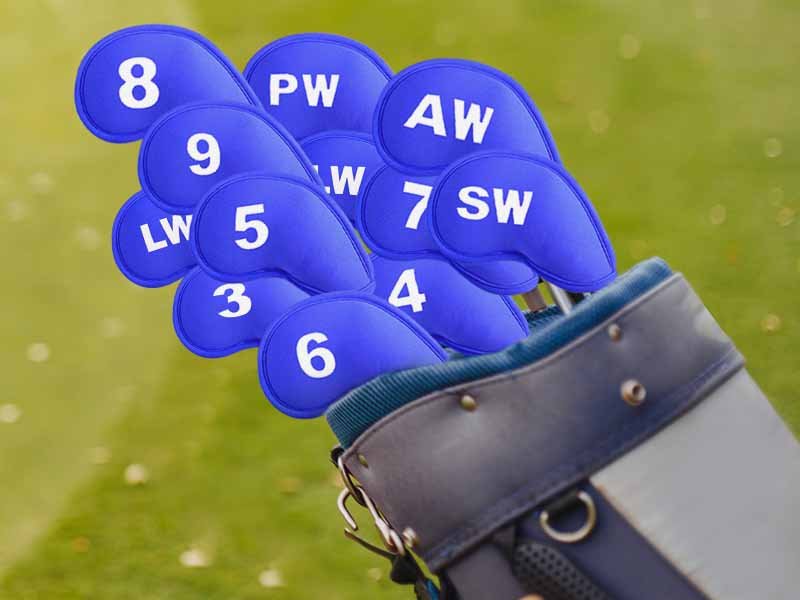
The best golf iron covers combine a secure fit, durable materials like neoprene or PU, easy on/off usability, and strong protection against scratches and moisture. Key factors include material thickness, stretchability, closure type, numbering visibility, water resistance, and compatibility with different club sizes. A great iron cover set protects forged irons, preserves resale value, and stays easy to use during regular play and travel.
When you search online for iron covers, you’ll see hundreds of options—different colors, shapes, materials, closures, even noise levels. But only a small percentage qualify as “best,” and the criteria go far beyond aesthetics. Great iron covers solve multiple pain points simultaneously: protection, usability, durability, and comfort during play.
Let’s break down the factors that truly matter.
1. Material Quality: The Foundation of a Good Iron Cover
Material determines almost everything—fit, durability, water resistance, and long-term performance. Among all materials, neoprene dominates the market for a simple reason: it stretches without losing shape, absorbs impact, and resists water naturally.
| Material | Protection | Stretch Flexibility | Water Resistance | Longevity | Best For |
|---|---|---|---|---|---|
| Neoprene | ★★★★★ | ★★★★★ | ★★★★☆ | ★★★★☆ | Everyday golfers |
| PU Leather | ★★★★☆ | ★★☆☆☆ | ★★★★☆ | ★★★★☆ | Stylish golfers |
| Genuine Leather | ★★★★☆ | ★☆☆☆☆ | ★★★☆☆ | ★★★★★ | Premium aesthetics |
| Knit Fabric | ★★★☆☆ | ★★★☆☆ | ★★☆☆☆ | ★★★☆☆ | Fun designs |
| Rubber/Silicone | ★★★★☆ | ★★★☆☆ | ★★★★★ | ★★★☆☆ | Wet conditions |
Neoprene remains the industry standard—and Szoneier specializes precisely in high-elasticity neoprene production, which is why many brands source OEM/ODM iron covers from China.
2. Fit and Compatibility: A Small Detail with Big Consequences
You may not notice it immediately, but the fit of an iron cover determines whether you enjoy using it. Too loose? It falls off during walking. Too tight? You struggle getting it back on, slowing down play.
Great covers typically feature:
- A snug-but-stretchy neoprene or PU construction
- A reinforced opening that doesn’t loosen over time
- A shape molded to modern iron head geometries
- Compatibility with wider game-improvement irons
Golfers with Callaway, Ping, or TaylorMade oversized irons often need oversized neoprene covers rather than standard slip-ons.
3. Closure System: Magnetic, Zipper, Velcro or Slip-On?
A closure system might sound like a small detail, but it dramatically affects how enjoyable the covers are to use. Different golfers prefer different styles, and each option has clear strengths and weaknesses.
- Slip-on neoprene – The most popular option. Lightweight, quiet, flexible, and super easy to take on and off during a fast-paced round. No hardware, no noise, no complications.
- Magnetic closures – Sleek and premium with a luxury feel. They open with almost no effort and snap shut securely, but usually cost more and may collect debris over time.
- Zippers – Extremely secure and protective, ideal for travel or players who want maximum coverage. The trade-off is speed—they’re slower during shot-to-shot play.
- Velcro – Simple and user-friendly, especially for seniors or golfers with limited hand strength. However, Velcro tends to wear out faster and can become less sticky when exposed to dirt or moisture.
Most golfers eventually return to slip-on neoprene covers because they strike the best balance between convenience, durability, and quietness during play.
4. Visibility: Numbers and Color Coding Matter More Than You Think
If you’ve ever pulled a 7-iron and realized—oops—it was your 8-iron, you know this pain.
Clear numbers help you:
- Move faster
- Reduce mis-clubbing
- Stay confident during rounds
Good covers use heat-pressed or embroidered numbering that won’t fade after months of use.
5. Protection During Travel: The Hidden “Must-Have” Factor
For golfers who fly even once a year, travel-grade padding becomes critical.
Bags get tossed, dropped, pressed, and stacked. An unprotected iron set simply cannot survive airport turbulence without scratches.
This is why many golfers own two sets:
- Lightweight covers for everyday play
- Thick padded covers for flights and long road trips
6. Price vs. Value — Not All Expensive Covers Are “Best”
Price doesn’t always indicate quality.
Some $15 neoprene sets outperform $40 “premium” ones simply because they stretch better and stay secured.
What actually matters is:
- Stitching quality
- Number print durability
- Material elasticity
- Cover longevity after months of use
- Manufacturer reliability
A good iron cover should last 1–3 years depending on frequency of play.
Which Types of Golf Iron Covers Suit Different Golfers Best?
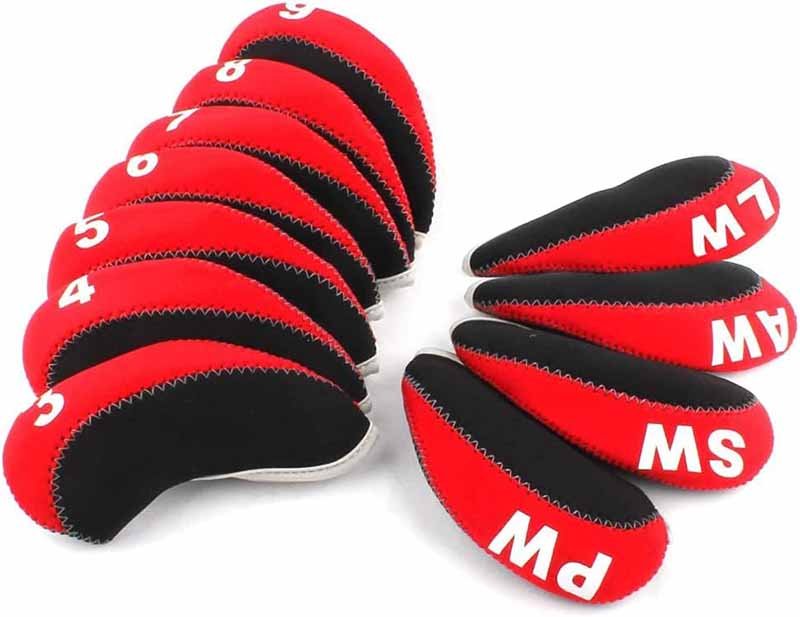
Different golfers need different types of iron covers based on their clubs, playing habits, and travel frequency. Beginners benefit from soft, flexible neoprene covers, while frequent travelers need padded or zipper-style protection. Low-handicap players often prefer minimalist slip-on designs for faster play, and golfers with oversized irons require stretchable, oversized neoprene covers. Choosing the right style depends on fit, ease of use, club shape, and personal preference.
Choosing the right iron cover is a lot like choosing the right set of irons—not every model suits every golfer. Some players prioritize speed, others want maximum protection, and some simply want something stylish without adding bulk. The trick is to understand your playing style and match it with a cover that won’t slow you down or frustrate you during a round.
1. For Beginners: Soft Neoprene Slip-On Covers (User-Friendly & Affordable)
Beginners usually want something simple, flexible, and reliable.
Why neoprene?
- Easy to slide on and off
- Soft and protective
- Works on almost any iron shape
- Budget-friendly
- Lightweight and quiet
New golfers are still building habits and consistency. Having an easy-to-use cover means they don’t need to fight with tight closures or worry about losing pieces mid-round. Slip-on neoprene is truly the “no-brainer” option for new players.
2. For Low-Handicap Players: Minimalist Covers for Faster Play
Lower-handicap golfers move quickly. They know their distances, choose clubs decisively, and hate anything that slows them down.
Many better players prefer:
- Thin neoprene covers
- Minimal stitching
- Fast removal and re-covering
- Lighter material
They want protection, but without feeling like they’re managing extra equipment. Minimalist covers offer the perfect balance.
3. For Golfers With Oversized or Game-Improvement Irons: Oversized Neoprene Covers
Brands like Callaway (Rogue, Mavrik), Ping (G series), and TaylorMade SIM/MAX lines produce irons with much larger heads.
For these golfers, standard iron covers often:
- Fit too tight
- Stretch excessively
- Tear at the seams
- Slide off during walking rounds
Oversized neoprene covers solve this problem with:
- Expanded head room
- Stretchable side panels
- Reinforced openings
These covers keep wide-soled irons fully protected without tearing or deforming.
4. For Frequent Travelers: Padded, Zippered, or Extra-Thick Covers
If you fly even once a year with your clubs, you need more than thin slip-on covers. Airlines don’t treat golf bags gently—bags fall off conveyor belts, get stacked, get squeezed in vans, or shift violently in turbulence.
Travelers should choose:
- Heavy-duty padding
- Zipper closures
- Thick neoprene or rubberized materials
- Reinforced stitching
A good travel-grade cover can prevent deep dents and scratches that could permanently damage forged irons.
5. For Seniors or Golfers With Less Grip Strength: Velcro or Wider-Opening Designs
Not every golfer has strong or flexible hands. Some deal with arthritis, stiffness, or reduced grip power.
In these cases:
- Velcro covers
- Wider slip-on openings
- Looser neoprene fits
…are significantly easier to use than zippers or magnetic closures.
6. For Style-Focused Golfers: Magnetic or Leather-Style Covers
Some golfers simply want their bag to look incredible.
For them, premium-style options include:
- Magnetic leather-style covers
- PU leather embossed designs
- Color-matched number sets
- Custom embroidered covers
These options place aesthetics and branding at the top of the list while still providing solid protection.
7. For Retailers, Shops, or Tournament Gifts: Custom-Printed Neoprene Sets
If you run a golf shop, resort, or brand, you need covers that:
- Are fully customizable
- Work for most club styles
- Offer good durability
- Look premium without costing premium
- Can be produced at scale
This is where OEM/ODM neoprene manufacturers like Szoneier shine—low MOQ, fast sampling, logo printing, color matching, and bulk pricing.
What Are the 15 Best Golf Iron Covers You Can Buy?
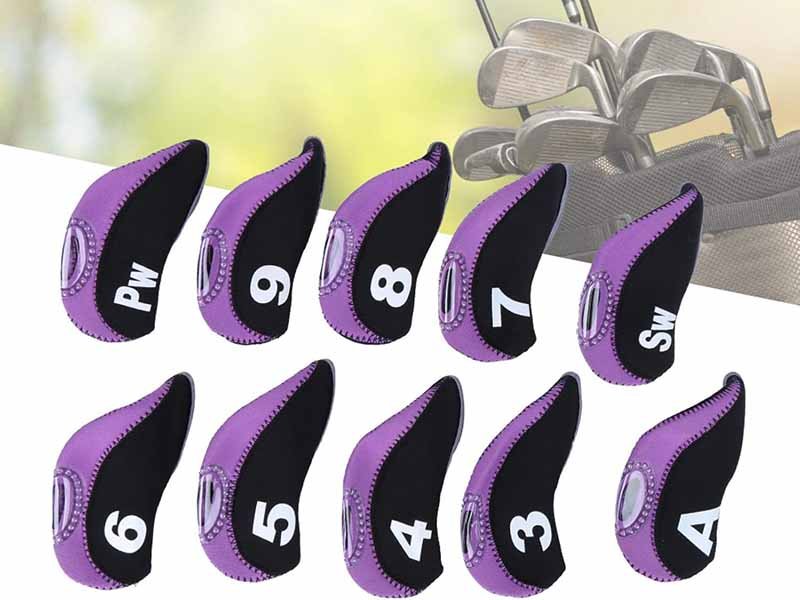
1. Craftsman Golf Neoprene Iron Covers
Craftsman Golf neoprene iron covers are known for their stretchy fit, strong durability, and clean numbering system. They conform tightly to any iron shape, making them ideal for forged and oversized game-improvement irons. Lightweight and quiet, they are a favorite among golfers who want maximum protection without slowing down play.
Craftsman Golf is one of those brands that golfers talk about even when they’re not shopping for accessories. Their neoprene iron covers have become a must-have because they solve the most common frustrations golfers have: loose-fitting covers, fading numbers, and materials that stretch out too quickly. Craftsman’s neoprene formula is slightly thicker than generic covers, giving a more padded feel. When you slide them on, they hug the clubhead—you can almost feel the protective tension.
One thing golfers love is how quiet they make the bag. The “clank, clank, clank” of irons bouncing against each other disappears immediately. Walking golfers especially appreciate this; it makes early-morning rounds more peaceful.
These covers also work beautifully for oversized irons. If you play Ping G-series, Callaway Rogue/Mavrik, or TaylorMade SIM/MAX clubs, these covers stretch just enough to accommodate wider soles without deforming.
A small detail, but important: the numbers. They’re bold, easy to read, and resist peeling even after months of pulling covers on and off. If you’re looking for reliable protection without any gimmicks—something that simply works day after day—Craftsman Golf is one of the safest choices.
2. Finger Ten Soft Neoprene Iron Covers
Finger Ten iron covers offer excellent value with flexible neoprene, strong stitching, and bright color options. They’re perfect for golfers who want reliable protection at an affordable price and are especially popular among beginners and high-frequency players.
Finger Ten is a brand that understands the practical golfer—someone who wants protection without paying a premium. Their iron covers are highly rated because they strike a strong balance between affordability and quality. Finger Ten uses a softer neoprene blend that feels lighter and easier to stretch than many mid-tier covers. This makes them ideal for golfers who prefer quick on/off action without wrestling the material.
The color options are another big plus—blue, red, black, grey, multi-color sets—allowing golfers to match or personalize their bags. Some golfers even use color coding to identify wedges or special-purpose irons.
Although these covers are budget-friendly, the stitching holds up surprisingly well. They maintain their elasticity after months of use, and the numbers stay readable even under sunlight. For beginners buying their first iron protection set—or experienced golfers needing durable “daily-use” covers—Finger Ten is one of the strongest value picks.
3. Club Glove Premium Neoprene Iron Covers
Club Glove neoprene iron covers deliver premium protection with extra-thick padding and a sleek, form-fitting design. They are perfect for golfers who demand tour-level durability and want their clubs fully protected during travel or frequent play.
Club Glove is synonymous with premium travel gear in the golf world, and their iron covers reflect the same philosophy: durability above all else. If you’ve ever flown with your clubs or tossed them in a car trunk, you’ll understand instantly why these covers exist. They are thicker than standard neoprene covers, giving a cushioned feel that inspires confidence. Many serious golfers buy Club Glove specifically for travel rounds or tournament trips.
What makes these covers stand out is their ability to maintain structure. Even after a year of weekly play, they don’t stretch out or feel loose. The neoprene snaps back the moment you remove or reapply it, which is rare in many cheaper models.
They also offer one of the most secure fits on forged blades. If you own Mizuno, Srixon, Titleist, Miura, or Honma forged irons, you’ll appreciate how the covers mold tightly to the head shape.
A small but thoughtful addition: the number placement. It’s positioned at an angle that stays visible even when the clubs are sitting tightly in the bag. These covers don’t just protect—they help you select clubs faster.
4. Maxfli Padded Neoprene Iron Covers
Maxfli padded neoprene covers provide enhanced impact absorption, making them ideal for golfers who want extra protection without bulky hardware. Their slip-on design and moderate thickness offer a good balance between convenience and durability.
Maxfli’s padded neoprene iron covers are a great mid-point for golfers who want more protection than standard neoprene provides but don’t want the inconvenience of zippers or magnetic closures. The padding is noticeable—it feels soft, cushioned, and slightly plush compared to basic slip-on models.
These covers shine for golfers who ride in carts often. Cart play creates more vertical movement and vibration, meaning irons hit each other harder than during walking rounds. The extra padding absorbs a surprising amount of this impact, keeping forged heads looking fresh.
Maxfli’s design is also easy to grip. The slightly textured neoprene surface gives traction, which is helpful when removing covers in wet conditions. They also maintain their shape well over time.
For golfers who prefer a “premium but not overly expensive” option, Maxfli padded covers hit the sweet spot—use them for every round, or keep them as your designated “travel set.”
5. Magnetic Leather-Style Iron Covers
Magnetic leather-style iron covers offer a luxurious look with convenient magnetic closures that snap shut effortlessly. Ideal for golfers who want a stylish, premium feel without compromising protection.
Among all the iron cover designs on the market, magnetic leather-style covers deliver the most “luxury bag” aesthetic. These are the covers golfers choose when they want an upscale appearance—something that pairs perfectly with a premium cart bag or a meticulously color-coordinated setup.
The magic lies in the magnetic closure. Instead of forcing a zipper or struggling with tight neoprene openings, you simply open the flap, slide the club in, and the magnet clicks shut automatically. It feels satisfying every time—a subtle touch of convenience that makes rounds smoother.
The PU leather exterior gives them a polished look, while the inner padding protects the clubhead from both light scratches and harder knocks. Although these aren’t as flexible as neoprene, they offer better structure, making them easier to handle for golfers who want something more rigid.
Keep in mind: because magnets are embedded inside, these covers tend to be slightly heavier. They’re best for golfers who value style and smooth usability over ultra-lightweight designs.
6. OEM-Branded Iron Covers (Callaway, TaylorMade, Titleist, etc.)
OEM-branded iron covers from Callaway, TaylorMade, Titleist, and other major golf brands offer reliable protection with matching aesthetics. They appeal to golfers who prefer brand consistency and want covers designed specifically for their club shapes and styles.
OEM iron covers are the “brand loyalist’s choice.” Golfers who carry a full Callaway, TaylorMade, or Titleist bag often prefer accessories that match the same brand identity. These covers are designed with precise sizing for each manufacturer’s club geometry—especially helpful for clubs with unique head shapes or wider soles.
One big advantage is fit accuracy. When a brand produces covers for its own irons, the sizing simply works: not too tight, not too loose, and shaped exactly for those specific heads. If you’ve ever tried generic covers on a set of Callaway Rogue ST or TaylorMade Stealth irons, you know how valuable a perfect fit can be.
The materials vary—some use neoprene, some use PU leather—but the build quality is generally reliable. Numbers are typically embroidered or heat-pressed with the same fonts found on the clubs themselves. This gives the bag a cohesive, polished look.
These covers are ideal for golfers who enjoy presenting a clean, unified setup. If you’re the type who color-matches your towel, gloves, and bag accessories, OEM-branded covers are your natural choice.
7. Zipper-Style Anti-Slip Iron Covers
Zipper-style iron covers provide maximum security by fully enclosing the clubhead. They are ideal for golfers who travel often, experience heavy bag movement, or want a cover that never slips off during rounds.
Zipper-style iron covers are the workhorses of the protection world. Their defining feature—a full zippered enclosure—means the clubhead is locked in place. Nothing slips, nothing shakes loose, and the club stays shielded from all angles.
These covers are perfect for golfers who frequently ride in carts or travel with their clubs. When a bag hits bumps or gets tilted, zippers keep everything fully contained. Forged irons, which dent easily, benefit the most from this extra security.
There is, however, a trade-off: zippers are slower. If you’re the type of golfer who plays fast or dislikes extra steps, zippered covers may interrupt your rhythm. But for golfers who prioritize maximum protection—especially during transport—these covers are worth the slight inconvenience.
Another advantage is material versatility. Many zipper covers use:
- thicker neoprene
- padded nylon
- PU leather
- hybrid fabrics
…making them strong enough for rough handling and long-term storage.
If you’re the kind of golfer who wants your clubs to look flawless years from now, zipper covers are the protection-focused solution
8. Oversized Neoprene Iron Covers
Oversized neoprene iron covers are designed for wide-soled game-improvement irons, offering extra stretch and space. They ensure a secure fit without overstretching or tearing, making them essential for golfers with large modern clubheads.
Not all irons are created equal. Many modern game-improvement or super game-improvement irons—like Ping G-series, TaylorMade SIM MAX, or Callaway Big Bertha—have significantly larger heads. Standard covers often struggle to fit these shapes, which is why oversized neoprene covers exist.
These covers feature:
- Expanded toe and sole areas
- More flexible neoprene blends
- Reinforced stitching
- Wider openings for easier slip-on use
They stretch gently around the iron rather than fighting against it. This matters because forcing a tight cover onto a bulky iron can tear seams and damage both the cover and the club. Oversized designs solve that once and for all.
Golfers who use hybrids in place of long irons also benefit, as oversized neoprene often fits hybrid heads better than traditional hybrid-specific covers.
Another nice feature is durability. Because these covers don’t get overstretched daily, they maintain elasticity longer. If you own large clubs, oversized neoprene isn’t a luxury—it’s a necessity.
9. Minimalist Slip-On Neoprene Iron Covers
Minimalist slip-on iron covers are lightweight, quick to use, and ideal for golfers who prioritize speed and convenience. They offer enough protection for daily play without adding bulk or slowing down club selection.
For golfers who like protection but hate fuss, minimalist slip-ons are the sweet spot. They’re made with thin yet durable neoprene that slides on smoothly and comes off instantly. No zippers, no magnets, no Velcro—just a clean, simple design.
These covers are great for walking golfers who want to keep noise to a minimum without carrying bulky accessories. They also work well for players who remove covers between shots and re-cover between holes—something that’s nearly impossible with zipper or magnetic styles.
Because minimalist covers are thinner, they don’t add weight to the bag. Many golfers say they “forget the covers are even there,” which is exactly the point.
If your main goal is fast, no-nonsense protection, minimalist slip-ons are the most natural fit.
10. Knit / Fun-Design Iron Covers
Knit and novelty-design iron covers appeal to golfers who want personality and color in their golf bags. They provide moderate protection while adding a fun, expressive style that stands out on the course.
Knit iron covers are the most playful option on the list. Instead of looking sleek and modern like neoprene or leather-style covers, they bring personality—stripes, bold colors, cartoon themes, even animal-inspired patterns.
These covers aren’t just “cute”; they’re a great conversation starter. Many golfers use them to make their bags unique, especially in leagues or group outings where everyone carries similar equipment.
Functionally, knit covers offer moderate protection. They cushion light impacts and prevent cosmetic scratches but aren’t ideal for rough travel. The stretch is good, though, making them easy to use.
They’re perfect for:
- golfers who love decorating their gear
- junior players
- women’s leagues or mixed leagues
- tournament giveaways
- holiday or themed rounds
If protection is your top priority, choose neoprene. But if personality and style matter just as much as function, knit covers are a fun, memorable choice.
11. Personalized Embroidered Neoprene Iron Covers
Personalized embroidered neoprene iron covers allow golfers to add names, initials, logos, or custom designs. They offer strong protection with a premium personalized touch, making them popular for gifts, tournaments, and brand-building. These covers combine durability, flexibility, and customized identity.
Personalized embroidered neoprene iron covers speak to golfers who want more than generic designs. They want ownership—something that feels custom-built, reflects personality, and stands out on the course. Embroidery elevates the look significantly. Unlike printed graphics, embroidery produces texture, depth, and richness that signals quality.
These covers are especially popular for golf gifts. Many players customize them with initials, monograms, team names, or even witty phrases. Tournament directors also love them because embroidered sets make premium welcome gifts or prize items.
Functionally, personalized neoprene covers offer the same advantages as standard neoprene:
- strong stretch
- shock absorption
- quiet movement
- long-term durability
But the embroidered element adds thickness and strengthens the fabric at the design area, making them slightly more robust.
These covers are ideal for players who want a personal identity marker in their bags—or want to avoid losing covers during group rounds. Nothing is more distinctive than your initials stitched onto each club.
12. Budget Multi-Color Neoprene Iron Covers
Budget multi-color neoprene iron covers offer affordable protection with bright, easy-to-identify numbers and color-coded designs. They’re ideal for beginners, recreational golfers, and players who want functional covers without spending much.
Not everyone needs premium magnetic or leather-style covers. Many golfers—especially new players—want simple, reliable protection without overspending. Budget multi-color neoprene covers fill that need perfectly. They’re light, flexible, and cost a fraction of premium sets while still offering solid protection.
One of their greatest advantages is color-coding. Different colors for different clubs help newer golfers stay organized. A quick glance at the bag and you instantly know where your 7-iron or 9-iron is located. This is particularly useful for juniors, casual golfers, or seniors who appreciate visual clarity.
Despite the low price, these covers still offer the core benefits of neoprene:
- stretchability
- shock absorption
- lightweight feel
- good clubhead coverage
And since they’re affordable, golfers don’t stress if one gets lost or damaged—simply replace the set.
They’re the perfect entry-level option and a smart choice for golfers who want everyday protection without worrying about fancy aesthetics.
13. Travel-Grade Padded Iron Covers
Travel-grade padded iron covers provide maximum protection for flights, car rides, and long-distance travel. Their thick cushioning, secure fit, and durable construction shield clubs from impacts, making them ideal for golfers who travel often.
Travel is where golf clubs suffer the most abuse. Airport conveyor belts, car trunks, stacked luggage—iron heads take a beating long before golfers step onto the first tee. Travel-grade padded covers exist for this exact reason. They provide thick padding around all sides, giving clubs a protective barrier that can withstand hard impacts.
Unlike everyday slip-on covers, travel-grade models use heavy-duty neoprene, foam layers, or rubberized materials. Some include zipper closures to fully wrap the clubhead. These covers feel substantial in your hands—more like protective gear than accessories.
For golfers who fly even once a year, these covers can prevent:
- dents
- chips
- finish wear
- deep scratches
- bent edges
- face damage
Many golfers keep two sets of covers:
lightweight neoprene for daily rounds
padded covers exclusively for travel
If you’ve invested in expensive forged irons, padded travel covers almost feel like an insurance policy—a protective layer that preserves the clubs’ value and performance.
14. Eco-Friendly / Recycled Neoprene Iron Covers
Eco-friendly iron covers use recycled neoprene or sustainable materials to reduce environmental impact. They offer similar protection and flexibility as standard neoprene covers but appeal to golfers who prioritize sustainability and modern eco-conscious design.
Sustainability is becoming an important theme in golf. From recycled balls to biodegradable tees, golfers are increasingly thinking about environmental impact—and iron covers are no exception. Eco-friendly or recycled neoprene covers are designed to provide the same performance as classic neoprene, but with reduced waste and a cleaner production footprint.
These covers use materials sourced from recycled wetsuits, leftover manufacturing neoprene, or post-consumer neoprene scraps. The recycled blends still maintain:
- flexibility
- water resistance
- cushioning
- durability
What makes these covers stand out is the story behind them. Golfers appreciate gear that feels responsible and contemporary. Pro shops and resorts also love offering eco-friendly accessories because they align with modern values.
Designs tend to lean minimalist—matte black, grey, earthy tones—giving a clean and modern aesthetic. If you’re a golfer who wants to make a small but meaningful environmental choice, eco-friendly covers are a great place to start.
15. Custom-Printed Neoprene Iron Covers From Chinese Manufacturers
Custom-printed neoprene iron covers from Chinese manufacturers offer full customization with low MOQs, fast sampling, and flexible design options. They’re ideal for brands, shops, tournaments, and businesses looking to create unique and affordable golf accessories.
This final category is one of the fastest-growing segments in the industry. Custom-printed neoprene covers produced by experienced Chinese manufacturers—like Szoneier—deliver exceptional flexibility in design, price, and production.
You can customize virtually everything:
- full-color artwork
- patterns, gradients, and textures
- club numbers
- brand logos and corporate branding
- color-matched trims
- special-edition series
Thanks to advanced heat-transfer printing and high-elastic neoprene, manufacturers can reproduce complex graphics while keeping the covers lightweight and functional. This makes them ideal for:
- golf shops
- country clubs
- resorts
- corporate golf events
- product giveaways
- new golf brands
- subscription golf boxes
A major advantage is low MOQ. Many factories start at just 50–100 sets, making it possible for small businesses or boutique brands to launch without heavy investment.
Factories like Szoneier provide:
- free design support
- fast sampling (3–7 days)
- stable quality control
- reliable mass production
- competitive wholesale pricing
For any shop or brand wanting “their own” iron covers—not just reselling generic products—custom-printed neoprene covers are the most versatile and profitable choice.
How Do You Use and Maintain Golf Iron Covers Correctly?
Using golf iron covers correctly means measuring your irons for the right fit, applying and removing covers efficiently during play, cleaning them regularly, and preventing moisture that can cause rust. Proper maintenance keeps both the covers and clubs in excellent condition, extending their lifespan and ensuring consistent performance.
How Do You Measure Irons to Ensure Proper Fit?
Measure your iron’s clubhead width, sole thickness, and face height to determine the correct cover size. Oversized irons need larger, stretchable neoprene covers, while players’ irons fit standard covers. A proper fit prevents slippage, overstretching, and premature wear.
Most golfers buy iron covers without checking whether they actually fit their clubs. But every iron set is different—blades are compact, game-improvement irons are bulky, and super-GI soles can be massive. A few simple measurements can save you from loose, sliding covers or overly tight ones that tear after a month.
1. Measure Heel-to-Toe Width
This is the most important dimension.
- Players’ irons: 3.0″–3.35″
- Game-improvement irons: 3.4″–3.7″
- Oversized irons: 3.75″+
If your clubhead falls into the last category, you must choose oversized neoprene covers.
2. Measure Sole Thickness
Wide soles need deeper covers.
- Blades: 0.6″–0.8″
- Game-improvement: 0.9″–1.1″
- Super game-improvement: 1.2″+
Tight covers will stretch excessively and eventually rip at the seam.
3. Measure Face Height
Taller irons need covers that reach over the entire face.
- Blades: 1.7″
- GI irons: 1.9″–2.1″
If the cover doesn’t reach the bottom of the face, debris and moisture can enter.
4. Compare With Manufacturer Sizing Charts
Premium brands often provide size guides.
This is especially helpful for Ping G series, which are notoriously wide.
5. Double-Check Wedges
Wedges vary wildly in shape and edge angle.
Sometimes wedges require a slightly larger cover than the 9-iron.
Bottom Line
A proper fit feels snug, not tight.
A good rule: if you need both hands to force a cover on, the size is wrong.
How Should You Use Iron Covers On-Course Without Slowing Play?
Remove the cover before reaching your ball, re-cover between holes instead of after every shot, and keep covers organized in one pocket. Slip-on neoprene covers are the fastest option and allow golfers to use covers without interrupting pace of play.
Iron covers only slow golfers down when they’re used incorrectly. With a good routine, you can protect your clubs while maintaining a smooth pace.
1. Remove Covers Before You Reach the Ball
As you approach your next shot—20 or 30 yards out—remove the cover and place it in a consistent pocket.
This saves the awkward pause at the ball that slows everything down.
2. Re-Cover Only Between Holes
One of the biggest myths is that golfers need to put the cover back on after every single shot.
You don’t.
The most efficient flow is:
- Remove before the shot
- Hit your shot
- Walk/ride
- Replace the cover only after the hole is complete
You protect your irons and stay fast.
3. Organize Covers by Keeping Them in One Pocket
Scattering covers in different pockets is the main cause of delays.
Create a “cover pocket” and always return covers there.
Some golfers use a ring or carabiner to clip covers—they remove and clip them instantly.
4. Use Slip-On Neoprene for Maximum Speed
Zippers, magnets, and Velcro slow you down.
Slip-on neoprene is the most efficient for in-round usage.
5. Avoid Removing Covers on Wet Ground
Wet grass makes covers stick and creates awkward slips.
Remove them while walking, before reaching your shot.
6. Build Muscle Memory
After a few rounds, the motion becomes automatic—like grabbing tees or marking your ball.
How Do You Clean Neoprene and Leather Iron Covers?
Clean neoprene covers with mild soap and lukewarm water, then air-dry fully. Clean PU or leather covers with a damp cloth and leather-safe conditioner. Avoid heat, soaking, or abrasive cleaners to prevent warping or cracking.
Golf courses expose your covers to dirt, pesticides, sand, and constant moisture. Over time, covers can smell, discolor, or degrade if not cleaned properly.
1. Cleaning Neoprene Covers (Safest & Easiest)
Neoprene is absorbent but durable.
Recommended method:
- Mix lukewarm water + mild dish soap
- Scrub gently with a soft brush
- Rinse thoroughly
- Air dry for 8–12 hours
Avoid:
- hot water
- dryers
- bleach
- detergents with alcohol
These break neoprene’s elasticity.
2. Cleaning PU Leather Covers
PU leather is more sensitive.
Do:
- wipe with a damp cloth
- use diluted soap for dirt
- immediately hand-dry
Avoid:
- soaking
- chemical spray cleaners
- prolonged sunlight exposure
PU leather can warp under heat.
3. Cleaning Genuine Leather
Leather needs moisturizing.
Use:
- leather conditioner
- microfiber cloth
- minimal water
Never saturate leather—it stains and stiffens.
4. Handling Odor or Mold
A teaspoon of vinegar in the wash water kills odor-causing bacteria.
If mold appears on PU or leather covers, wipe gently with a 1:10 vinegar-water solution.
Is Rust or Moisture Build-Up a Real Risk and How Do You Prevent It?
Yes, moisture trapped inside covers can cause rust—especially on forged carbon-steel irons. Prevent rust by drying irons before covering them, removing covers after wet rounds, and storing clubs in a ventilated space.
Rust isn’t a myth—it’s one of the leading causes of cosmetic damage on forged irons. While stainless steel is more resilient, carbon steel rusts rapidly if moisture is trapped between the metal and neoprene.
1. Why Moisture Accumulates Inside Covers
Moisture enters covers through:
- rain
- dew
- wet grass
- sweat
- damp towels in the bag
- humidity in garages or car trunks
Neoprene can trap droplets for hours.
2. Why Rust Forms So Quickly
Rust requires:
- oxygen
- water
- iron
Carbon steel contains higher iron content and oxidizes faster—sometimes overnight.
3. How to Prevent Rust
Preventive habits matter more than cleaning.
- Always wipe irons before covering
- Remove covers after rainy rounds
- Let covers and clubs air-dry overnight
- Keep silica packs in your golf bag
- Never store clubs in a closed car trunk
- Avoid storing in humid garages
4. What to Do If Rust Already Appears
For mild rust:
- apply WD-40
- wipe lightly with a microfiber cloth
For forged clubs, avoid abrasive pads—they can scratch the finish.
How Can Brands and Golf Shops Customize Neoprene Iron Covers With Their Own Logo?
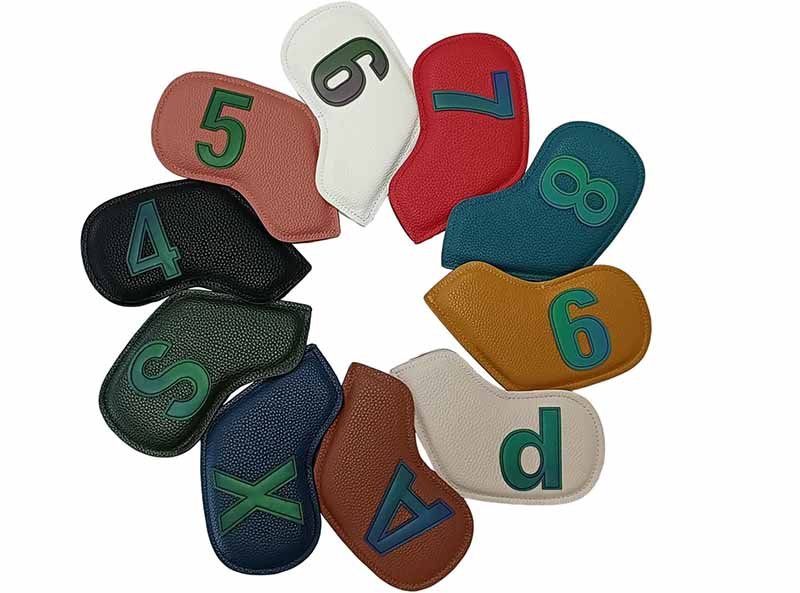
Brands and golf shops can customize neoprene iron covers by adding printed logos, embroidery, full-color artwork, numbering, and special shapes. OEM/ODM manufacturers like Szoneier offer low MOQs, fast sampling, and complete customization for retail, tournaments, and promotional use.
Customization has become a major trend in the golf accessory world. Golf shops, resorts, tournament organizers, country clubs, and growing golf brands all want unique, branded merchandise that stands out—and neoprene iron covers are among the most customizable items available.
1. Why Neoprene Is Ideal for Customization
Neoprene supports nearly every customization method:
- heat-transfer printing
- digital full-color graphics
- silk-screen logos
- embroidery patches
- 3D rubber logos
- metallic prints
- gradient and pattern designs
It stretches, recovers well, and maintains clarity even with complex artwork.
2. What Elements Shops Usually Customize
Popular customizations include:
- club numbers (3–LW)
- company logos
- golf shop branding
- course names
- resort logos
- event graphics
- anniversary or tournament designs
- limited-edition series
Custom iron covers sell extremely well in pro shops and resort stores because golfers love souvenirs from courses they’ve played.
3. MOQ, Pricing & Production Flexibility
Manufacturers like Szoneier offer:
- low MOQs (50–100 sets)
- free design assistance
- fast sampling (3–7 days)
- mass production in 15–25 days
- color-matched printing
- custom packaging options
This flexibility makes it easy for small businesses or new brands to launch custom products with minimal risk.
4. Popular Use Cases
- resort pro shops
- tournament prize packages
- golf subscription boxes
- startup golf brands
- corporate gifts
- country club member gifts
- charity event giveaways
Iron covers are light, easy to ship, and universally useful.
5. Why Szoneier Is a Trusted OEM/ODM Partner
With 18+ years of neoprene expertise, Szoneier offers:
- stable material quality
- consistent stitching & durability
- competitive factory pricing
- flexible customization
- fast response & fast sampling
- complete supply chain support
For brands wanting to create their own premium iron covers, Szoneier is one of the most reliable and efficient manufacturers to work with.
Conclusion — The Right Iron Covers Protect More Than Just Clubs
Golfers spend countless hours practicing, fitting, and perfecting their equipment choices—but the simplest form of protection is often the one people overlook. Iron covers might seem like a small detail, yet they influence how your clubs age, how your bag looks, how quietly you walk 18 holes, and even how much value your irons retain after years of use.
Whether you’re an everyday golfer who wants to reduce bag chatter, a frequent traveler who needs padded protection, or a golf shop looking to introduce a custom-branded product line, choosing the right iron cover set makes a real difference.
The truth is simple:
- Neoprene covers protect best during daily play
- Padded covers are essential for travel
- Oversized covers solve fit issues for modern irons
- Embroidered or printed covers build identity
- Custom covers help pro shops and brands stand out
If you understand your needs and pick accordingly, iron covers can last for years and keep your irons looking nearly new—something every golfer appreciates when they pull a clean, scratch-free 7-iron from the bag.

